With their bright colors and remarkable ability to mimic human speech, parrots are among the most popular birds among enthusiasts and the general public. There exist more than 398 species worldwide, broken up into three superfamilies: “true parrots” (Psittacoidea), cockatoos (Cacatuoidea), and New Zealand parrots (Strigopoidea). They range throughout tropical and subtropical climates, primarily in the Southern Hemisphere. Their lifespan is one of the longest of any bird species, and some species possess enough intelligence to manipulate tools.
From the tiny pygmy parrots of Papua New Guinea to the giant macaws of South America, parrots come in all sorts of sizes. But which species of parrot is the largest? To answer this question, you must measure their length and weight, with weight as the final determining factor to differentiate between species. In this list, we rank ten of the most massive parrots in the world to determine the largest of them all.
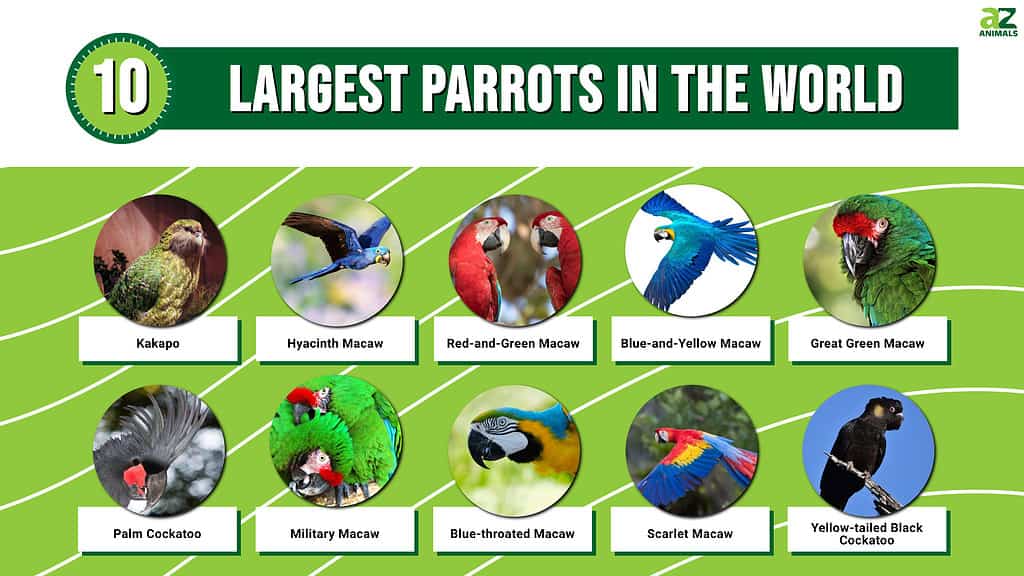
Keep reading for more information about these colorful and fascinating parrots!
#10: Yellow-Tailed Black Cockatoo

Originally known as the funereal cockatoo, the yellow-tailed black cockatoo (Zanda funerea) is a large species from eastern Australia. They can measure between 22-26 inches long and weigh up to 1.9 pounds. Its plumage is primarily brownish-black with pale yellow bands in the tail feathers, neck, nape, and wings. You can hear their loud, varied calls from long distances, which helps distinguish them from other species of black cockatoo.
Yellow-tailed black cockatoos range throughout southeastern Australia, including Tasmania, the Bass Strait Islands, and Kangaroo Island. They tend to live in temperate forests but will also take up residence in pine plantations and urban areas where food is plentiful. Their diet includes seeds from native trees, nectar, insect larvae, and pinecones. Although the IUCN lists the yellow-tailed black cockatoo as a species of Least Concern, their numbers continue to decrease due to habitat loss.
#9: Scarlet Macaw

The Scarlet Macaw lives in several countries in Central and South America.
©Jeff Schultes/Shutterstock.com
The scarlet macaw (Ara macao) is a large species of macaw from Central and South America. They can reach up to 32 inches in length and weigh and nearly 2.2 pounds at their heaviest. Their name comes from their striking red, blue, and yellow plumage, which distinguishes them from other macaw species and makes them one of the most popular exotic birds in aviculture. Honduras recognizes the scarlet macaw as its national bird.
Scarlet macaws are distributed from southeastern Mexico to the Peruvian Amazon, Ecuador, Colombia, Bolivia, Venezuela, and Brazil. They make loud, throaty squawks that carry for miles in every direction. Although commonly sighted alone or in pairs, they will occasionally travel in flocks. Their diet consists of fruits, seeds, nuts, flowers, and nectar. Although their population is in decline across several regions, large numbers still exist in the wild. As a result, the IUCN lists the scarlet macaw as a species of Least Concern.
#8: Blue-Throated Macaw
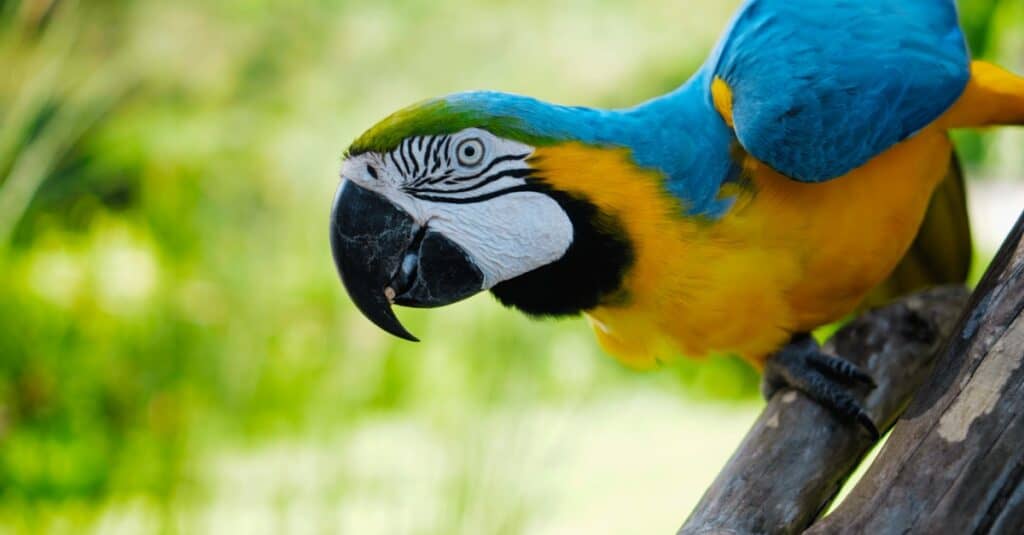
Blue-throated macaws live only in a single region of Bolivia.
©iStock.com/Nikolai Grigorev
The blue-throated macaw (Ara glaucogularis) is also known as Wagler’s macaw after the German herpetologist Johann Georg Wagler, who first described the bird to European readers. They can grow up to 33 inches long and weigh between 2.0-2.5 pounds. Their upper plumage appears turquoise-blue, while their bellies generally appear bright yellow. In addition, they sport a blue patch along their necks, which is where they get their name “blue beard” in Spanish.
Blue-throated macaws live only in the Llano de Moxos region of Bolivia. Unlike most parrot species, they do not live in forests, instead choosing to nest in islands of palm trees. While most blue-throated macaws live in monogamous pairs, they occasionally occur in groups of 7-9 individuals. They subsist primarily on palm tree fruit, although they will also eat seeds and nuts if no fruit is available. Blue-throated macaws are one of the rarest parrot species, as less than 400 still exist in the wild. The IUCN lists them as a Critically Endangered species.
#7: Military Macaw
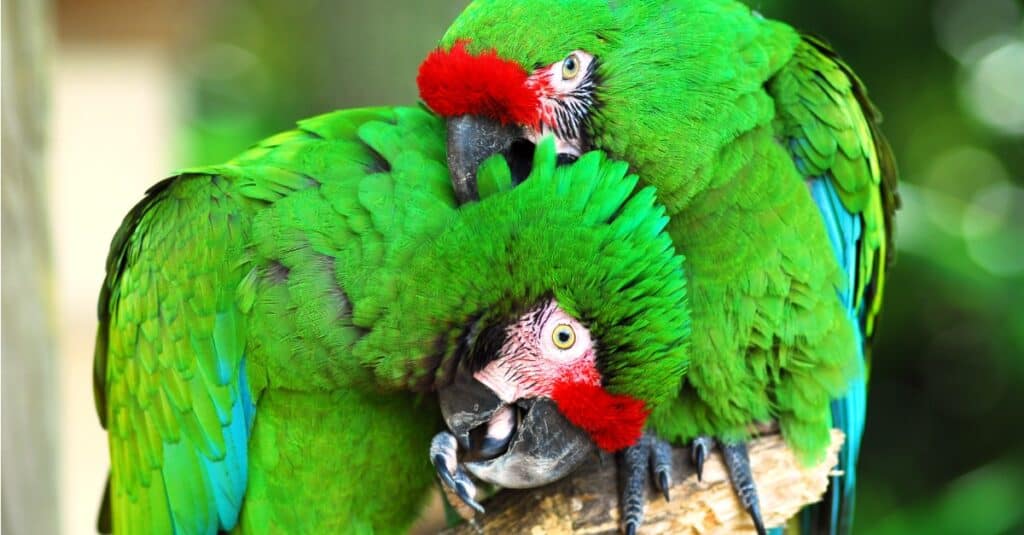
Military macaws are now listed as Vulnerable.
©iStock.com/Musat
The military macaw (Ara militaris) is a large parrot native to Mexico and areas of South America. They generally measure between 27.5-33.5 inches long and weigh around 2.5 pounds. Their name comes from their predominantly green plumage, which slightly resembles a military uniform. Although they appear similar to great green macaws, they are not quite as large, and their bills are black instead of white.
Military macaws inhabit deciduous and semi-deciduous forests in limited regions of Bolivia, Peru, Ecuador, Colombia, Venezuela, southern Mexico, and Argentina. Their diet consists primarily of seeds, but they will also feed on fruits and leaves. In addition, they will visit clay deposits known as “macaw licks” to feed on the clay deposits, which detoxify the poisons in the seeds and vegetables they eat. Around 2000-7000 exist in the wild, although much more live as pets. Due to their decreasing number, the IUCN lists them as a Vulnerable species.
#6: Palm Cockatoo
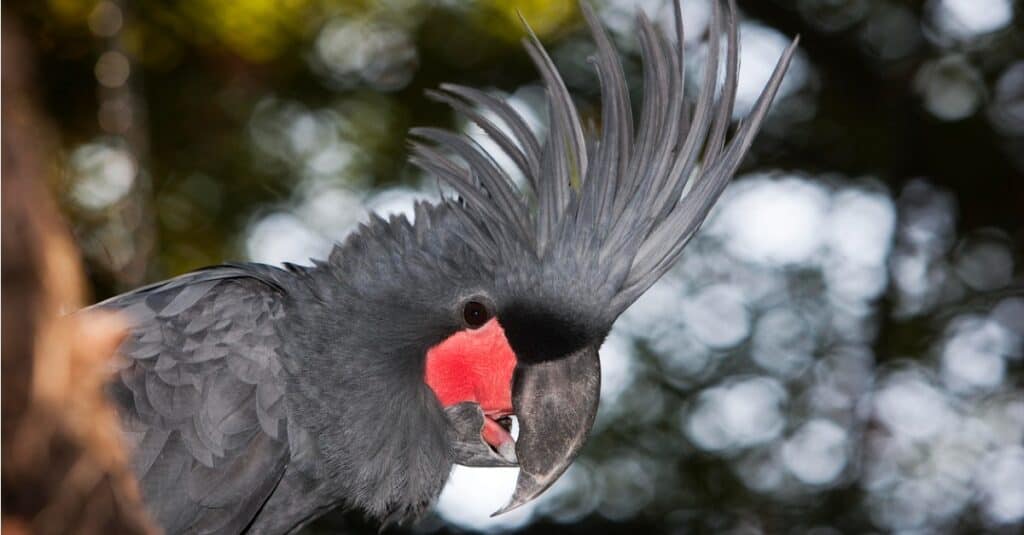
Palm Cockatoos have a distinctive appearance with their huge bills and head plummage.
©iStock.com/slowmotiongli
Also known as the goliath cockatoo or great cockatoo, the palm cockatoo (Probosciger aterrimus) is the largest parrot in Australia and the largest cockatoo in the world. While not quite as long as some cockatoo or macaw species, palm cockatoos weigh more than their longer cousins. They can measure between 22-24 inches long and weigh up to 2.6 pounds. Their grey-black plumage is broken only by prominent red patches located on their eyes. In addition, they possess huge bills, which are surpassed only by the bill of the hyacinth macaw.
Palm cockatoos occur in northeastern Australia, New Guinea, Sorong, West Papua, and Indonesia. Their diet consists of nuts from the kanari tree and fruit from the andanus palm, which is where they get their name. They partake in unique territorial displays, where a bird (normally a male) will drum a large stick against a tree. This makes them one of the few species of bird known to use tools. They also possess long lifespans, with estimated longevity between 80-90 years. Although listed as a species of Least Concern by the IUCN, populations of palm cockatoos face threats from habitat destruction and hunting.
#5: Great Green Macaw
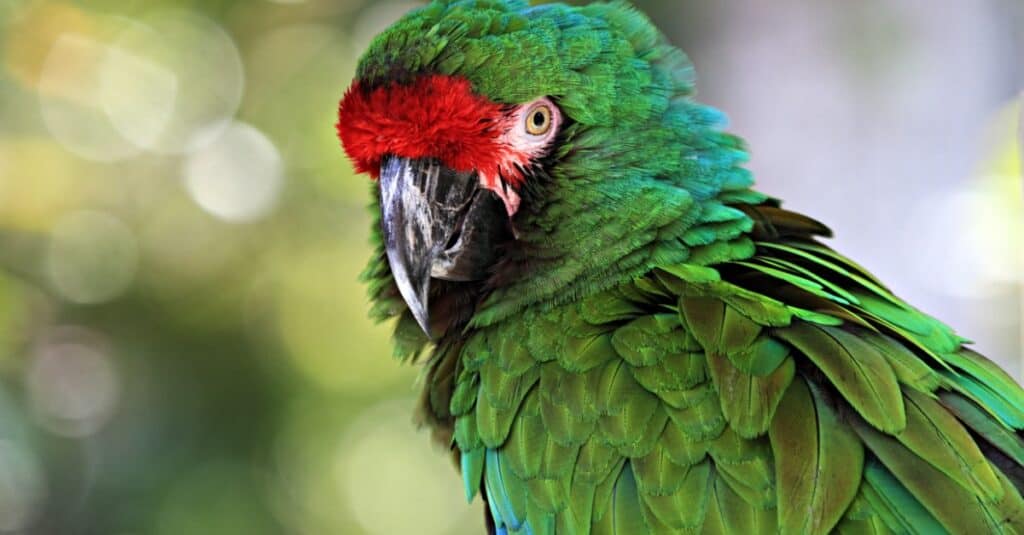
Some great green macaws live and breed in Costa Rica.
©iStock.com/Eva2k0
Also known as Buffon’s macaw or the great military macaw, the great green macaw (Ara ambiguous) is a large parrot native to Central and South America. They typically measure between 33.5-35.5 inches long and weigh up to 2.9 pounds. While they appear similar to the military macaw, their plumage is a lighter green color, and their beaks are white instead of black.
Great green macaws range from Honduras to Panama, Colombia, and western Ecuador. In addition, a segment of the species lives and breeds in Costa Rica. They prefer to live in tropical forests or evergreen forests, depending on the region. Their diet includes a wide variety of foods such as seeds, nuts, fruits, flowers, bulbs, roots, and tree bark. The total population of great green macaws that live in the wild is estimated at 7,000. Due to its limited population and threats from habitat destruction and the pet trade, the IUCN lists the great green macaw as a Critically Endangered species.
#4: Blue-and-Yellow Macaw
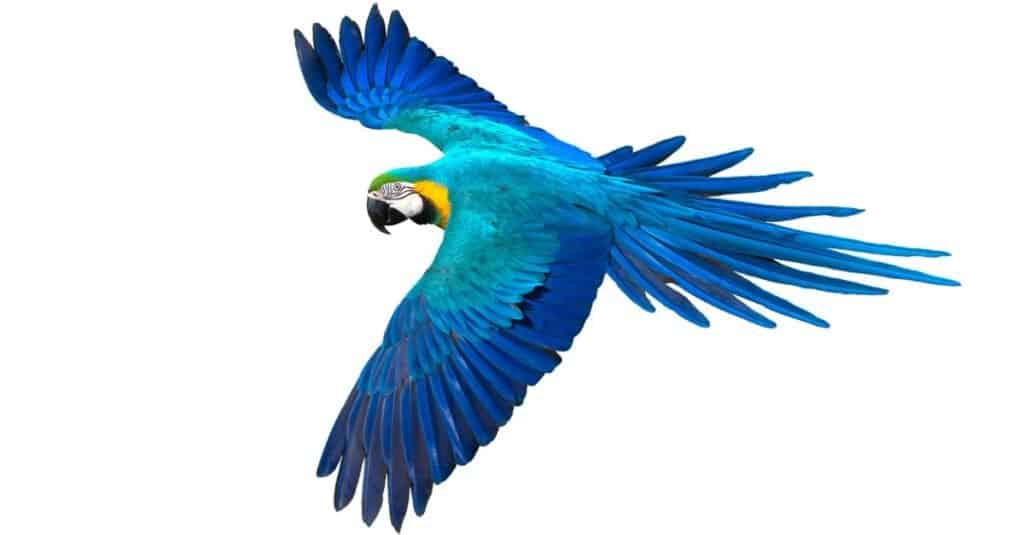
Blue-and-yellow macaws can live up to 70 years.
©BirdHunter591/Shutterstock.com
The blue-and-yellow macaw (Ara ararauna) is a popular species also known as the blue-and-gold macaw. While they measure slightly smaller than great green macaws at 30-34 inches long, they can weigh slightly heavier, reaching up to 3 pounds at their heaviest. Their radiant plumage is bright blue on top, while their bellies appear light orange. They possess a powerful beak which they use to break up nutshells and to climb up and hang from trees.
Blue-and-yellow macaws occur throughout Colombia, Venezuela, Brazil, Ecuador, Peru, and Paraguay. In the wild, they tend to live in forests, woodlands, and tropical savannahs. They can live for up to 70 years and possess remarkable mimicry abilities that allow them to “talk.” These factors, along with their brilliant colors, make them popular pets. They are one of the more common parrot species, with an estimated global population of 100,000. Although their numbers continue to dwindle, the IUCN currently lists them as a species of Least Concern.
#3: Red-and-Green Macaw
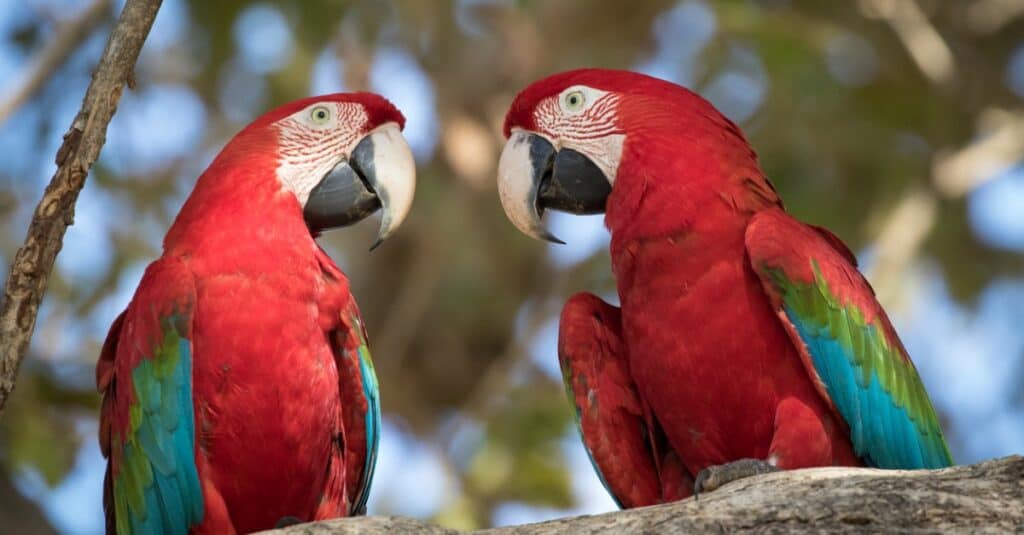
The red-and-green macaw mates for life.
©iStock.com/Pedro Ferreira do Amaral
The red-and-green macaw (Ara chloropterus), or green-winged macaw, is the largest macaw species in the genus Ara. They range from 35-37 inches in length and can weigh anywhere from 2.3-3.7 pounds. Their plumage is primarily red, but their wings also include shades of green and blue, which is where they get their name. They are one of the most recognizable macaw species, thanks to their striking appearance and common distribution.
Red-and-green macaws range throughout Brazil, Colombia, Bolivia, Ecuador, Peru, and Paraguay. They tend to nest in forests and woodlands, where they pair and mate for life. The number of red-and-green macaws in the wild is in decline due to hunting, habitat loss, and illegal capture of the pet trade. Still, at this time, the IUCN lists the red-and-green macaw as a species of Least Concern.
#2: Hyacinth Macaw
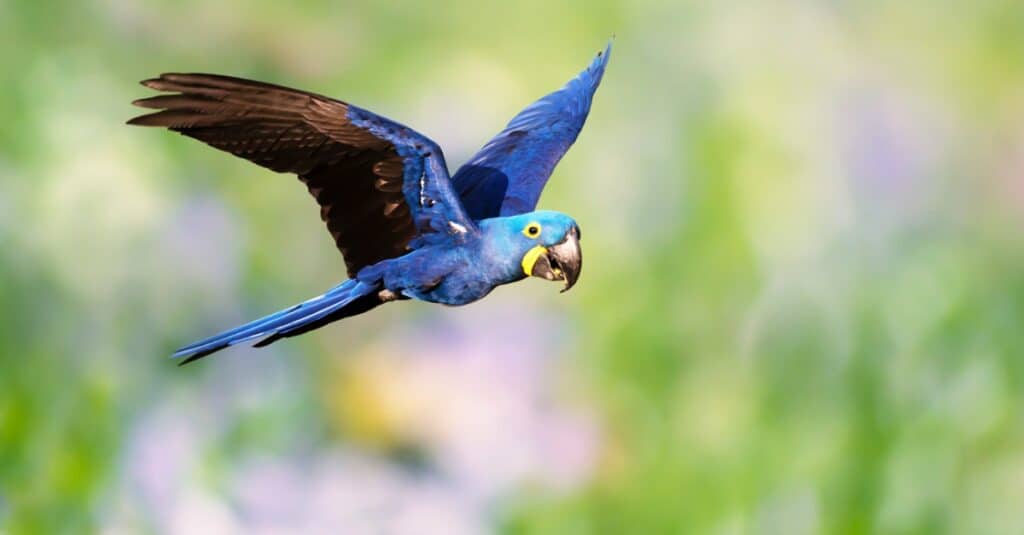
Hyacinth macaws are bright blue and the largest of the macaws.
©iStock.com/Dgwildlife
The hyacinth macaw (Anodorhynchus hyacinthinus) is the largest macaw in the world and the largest flying parrot species. They can measure up to 39 inches long and weigh anywhere from 2.3-3.7 pounds. While similar in appearance to Lear’s macaw, hyacinth macaws measure much larger. Their feathers are bright blue, with the only exceptions being a splash of yellow around their eyes and just underneath the beak.
Hyacinth macaws live in Brazil, eastern Bolivia, and northeastern Paraguay. They prefer to reside in palm swamps and woodlands and tend to avoid dense, humid forests. Their diet includes Brazil nuts, native palms, and fruits. Evidence exists that they use tools to help them break open harder nuts. Due to the pet trade and habitat loss, the IUCN lists the hyacinth macaw as a Vulnerable species.
#1: Kakapo
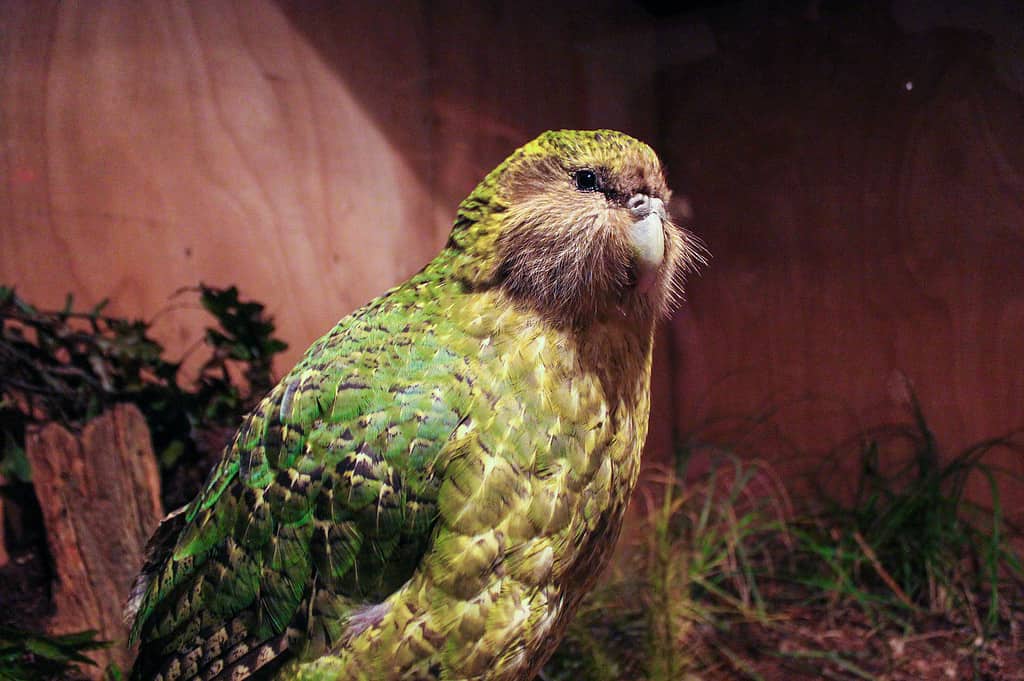
Kakapo sightings are exceedingly rare.
©Imogen Warren/Shutterstock.com
The kakapo is the largest parrot in the world. Also known as the owl parrot, the kakapo (Strigos habroptilus) is a large, flightless parrot part of the Strigopoidea family of parrots endemic to New Zealand. Although it is not nearly as long as most species of macaw, measuring between 23-25 inches long, it is the heaviest parrot in the world. On average, specimens weigh between 2-9 pounds, making them the most massive parrot species by far. Due to their size, kakapos are unable to fly and spend their entire lives on the ground. Mottled yellowish-green feathers cover their bodies, which allow them to blend in well with vegetation on the forest floor.
In the Maori language, their name translates to “night parrot,” a name they earned because Kakapos are nocturnal. Kakapos are the only parents that exhibit a polygynous breeding system, wherein one male mate with multiple females but females will mate with only one male. Their lifespan is exceptionally long, with reports of some specimens living up to 100 years old. They feed on native plants, seeds, fruits, and tree sap. After the British colonized New Zealand and introduced predators such as stoats, ferrets, and weasels to the islands, the native Kakapo population almost wholly disappeared. Today, less than 200 Kakapos live on the predator-free Codfish/Whenua Hou Island, Little Barrier/Hauturu Island, and Anchor Island, with each specimen named and tagged. Due to their reduction in numbers, the IUCN lists the Kakapo as a Critically Endangered species.
Summary of the World’s Largest Parrots:
| Rank | Parrot | Size |
|---|---|---|
| 1 | Kakapo | 23-25 inches long; 2-9 pounds |
| 2 | Hyacinth Macaw | 39 inches long; 2.3-3.7 pounds |
| 3 | Red-and-Green Macaw | 35-37 inches long; 2.3-3.7 pounds |
| 4 | Blue-and-Yellow Macaw | 30-34 inches long; up to 3 pounds |
| 5 | Great Green Macaw | 33.5-35.5 inches long; up to 2.9 pounds |
| 6 | Palm Cockatoo | 22-24 inches long; up to 2.6 pounds |
| 7 | Military Macaw | 27.5-33.5 inches long; 2.5 pounds |
| 8 | Blue-Throated Macaw | 33 inches long; between 2.0-2.5 pounds |
| 9 | Scarlet Macaw | 32 inches long; nearly 2.2 pounds |
| 10 | Yellow-Tailed Black Cockatoo | 22-26 inches long; up to 1.9 pounds |
The photo featured at the top of this post is © Charles Bergman/Shutterstock.com
Thank you for reading! Have some feedback for us? Contact the AZ Animals editorial team.






